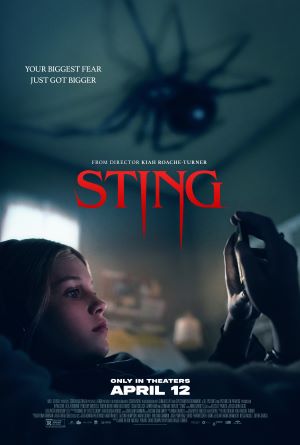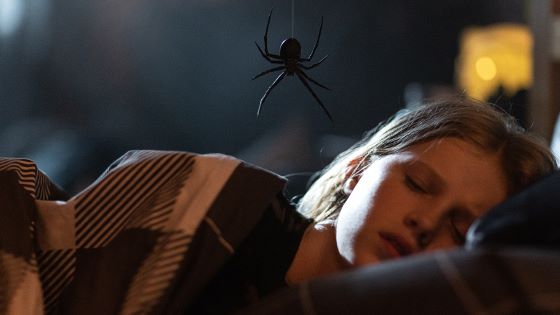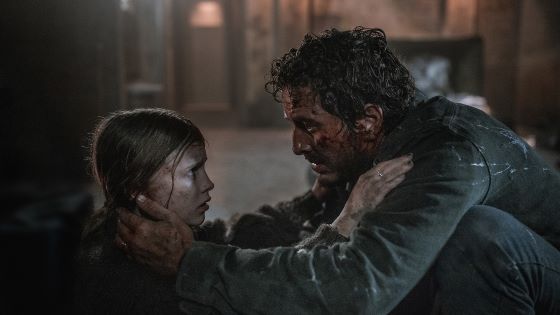

[Rating: Solid Rock Fist Up]
In Theaters April 12
A haunted house creature feature with creep-tastic bona fides, sturdy character work, and top-notch puppetry/FX, Sting is a masterclass in tight, smart, and efficient filmmaking. An obvious labor of love by somebody who is genuinely afraid of God’s most awful creation, the movie operates well within the guardrails it sets up for itself and knows just what buttons to press (and when). Serving up Joe Dante-meets-X-Files vibes with some of the best practical spider-effects ever put to film, writer/director Kiah Roache-Turner has crafted a horror thriller that is as clever as it is effective.
Set in a run-down Brooklyn tenement housing a collection of beleaguered residents that can’t afford better, Sting opens in media res, with a newscast voiceover establishing that the city is suffering through a terrible ice storm. There’s also mention of a passing asteroid cluster, which may or may not be the culprit for a freakish infestation of some sort: one serious enough to drag a full-grown man in pest control gear through a heating duct. A flashback to 4 days earlier all but confirms this, as plucky pre-teen Charlotte (Alyla Browne) is seen taking in a dime-sized spider that arrives via space-comet in the building where she resides with her mom, stepdad Ethan (Ryan Corr), and infant brother.
Charlotte names her new pet “Sting” and places it in a jar, feeding it a hearty diet of cockroaches while watching in morbid fascination as it doubles in size in just a day. And while Sting resembles an Australian Redback, its ability to mimic Charlotte’s phone chirp (not to mention its startling growth and intelligence) hint at its otherworldly zip code. An escape into the bowels of the building along with larger prey to nourish it allow the arachnid even more room to grow, and before long the tenants themselves on the menu.

Roache-Turner wastes no time setting the tone for this one with the cold open, employing whip-pans and hard (not quite dolly) zooms liberally, pairing this frantic visual aesthetic with grim-dark lighting and exquisite realist set design. The movie is telling the audience right off the bat that it has B-movie intentions with top-tier sensibilities: kind of like pairing a Budweiser with a plate of Sloppy Joe’s at a Michelin Starred restaurant. This duality is important, too, because Sting is not front-loaded to emphasize the horror elements, but rather uses them in support of a genuine exploration of family and parent-child dynamics.
A freaky-creepy yarn about a mutant space spider raising hell in an apartment building, sure, but the emotional core of Sting resides in the turbulent relationship between Charlotte and Ethan, who are struggling with the very natural and realistic complications of a blended family in turmoil. Both Ethan and Charlotte’s mom are stretched thin professionally, and with the new baby to look after, there is little time left over for a restless adolescent who takes turns admiring and resenting her stepdad. It’s a realistic portrayal of a very complicated dynamic, and as Sting starts collecting bodies and the stakes are raised, it creates buy-in for the audience and allows them to connect with these characters.
And besides all of that, it’s just scary AF. Once fully grown, Sting’s cephalothorax and abdomen are about the size of Pitbull, and if a smart, mean, goddamned dog-sized spider doesn’t scare the shit out of a person, then literally nothing can. The thing is REAL, too: and that makes all the difference. Weta workshop designed and operated the full-sized version of Sting, and the five-time Oscar winning company has proven once again why they are industry leaders in this field, lending the film and the action sequences a tactile and lived-in feel.

The script makes efficient use of each line and setting introduction in the movie’s crisp 90-minute runtime, too, establishing all the characters and locations with deliberate intention, yet not in a way that overly-telegraphs the action. And while not every character rings with authenticity, the core unit of Charlotte’s family holds this center well and carves out an emotional core that allows the wilder stuff the space it needs to flourish. And while it would have been nice for the heavy action to begin a little sooner (Sting doesn’t get into murder-mode until the 60-minute mark), the last third of the movie works as well as it does because Roache-Turner and his script have invested real emotional stakes into the story up to that point.
Strong performances from Browne and Corr carry Sting over the finish line otherwise, with the significant help of a Weta design and puppetry team that bring the eponymous spider to life and then some…[shudder]. At its core, this is a haunted house monster flick, yet what Roache-Turner manages to pull off with just the one setting, thoughtful character work, clever script set-ups, and dynamic creature effects elevates it beyond the schlock so many of its peers have leaned/fallen in to. And while the drama never rises to the level of awards-worthy pathos, it does just enough to keep the audience glued to the screen while a dog-sized spider works its way through the building’s HVAC ducts like some kind of carnivorous, eight-legged, outer space John McClane.





Comments on this entry are closed.